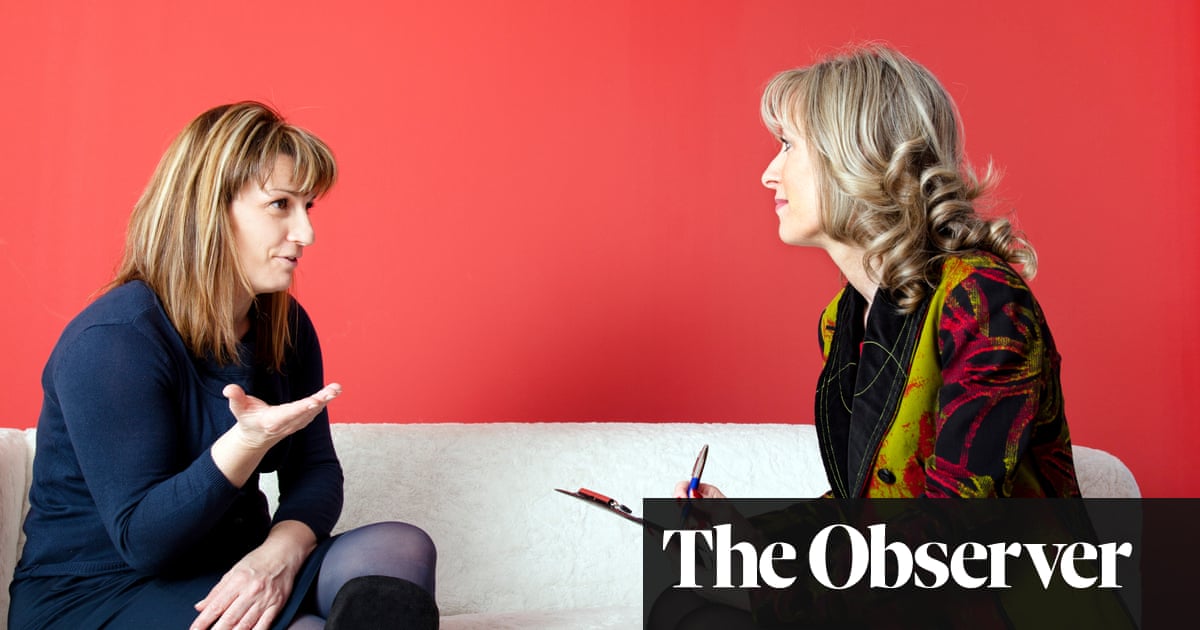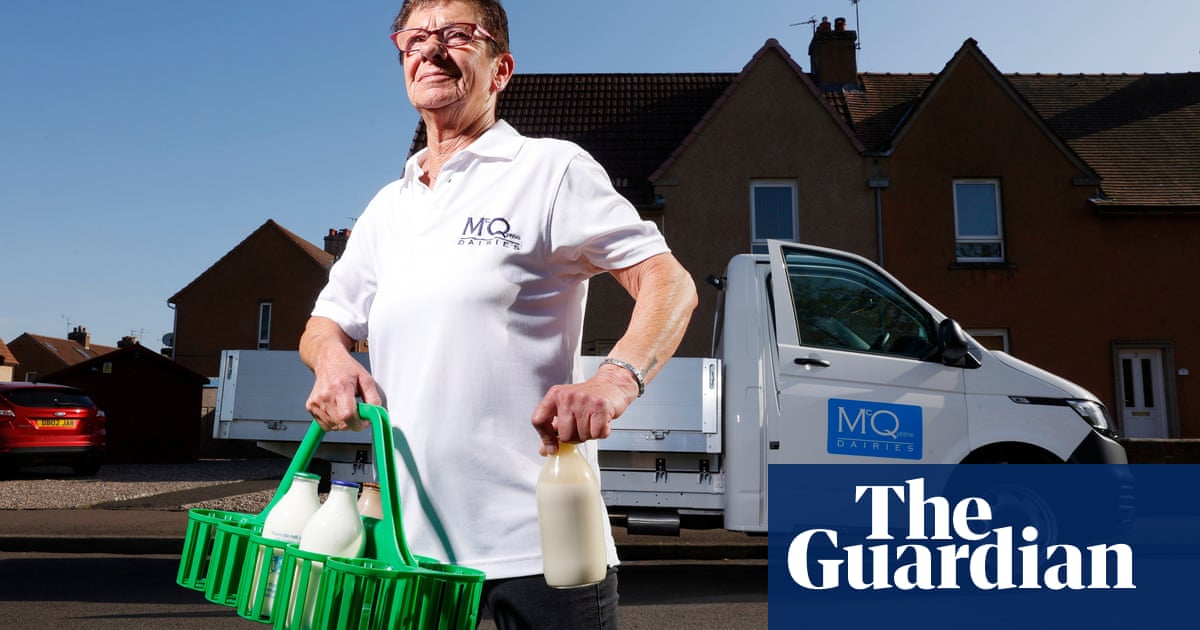
f curating your surroundings for a Zoom call is an art, then Laurence Llewelyn-Bowen is its maximalist master. Immersed in the dark colours of his 17th-century manor-house living room, he sits with enviable poise, one arm cocked and propped on his thigh, as though modelling for a portrait. Flanked by a medley of blue velvet and patterned cushions, the latter matching his William Morris-inspired sofa, he is lit by an assortment of lamps.
It is a stark contrast to my more modest framing – a single pine bookshelf and a large houseplant. I show him the rest of my living room: pale blue walls, a navy/charcoal sofa, a single cushion with Julianne Moore’s face, a coffee table, a few more palms and a TV unit. Britain’s best-known interior designer doesn’t spare my feelings.
“It might sound a bit extreme, but arson is a good starting point,” he says. “I’m assuming this is a perfect reflection of you, Chris?”
It’s a reflection of the fact my boyfriend and I live in a rented flat, with competing tastes and limited interest in furnishings. “Let me tell you, no one is winning,” he says, deadpan. He does offer advice, though: some sensible (bookcases need to be dark to show off their contents), some questionable (I need a denim blue feature wall) and some just bizarre (replace the curtains – and make our own out of dark grey blankets).
Llewelyn-Bowen was in Australia in March, filming the reality show House Rules, when the pandemic forced him back to the Cotswolds. The self-proclaimed “homestyle consultant” kept himself busy in lockdown, producing School of Flock, a series of YouTube videos in which he gives bite-size lectures on the history of design. His year grounded in the Cotswolds with his wife, Jackie, their two daughters and their daughters’ families has actually been quite pleasant; a privilege he recognises.
“Both Jackie and I were very powerfully moved by this enormous situation that was going on around us, despite the fact that materially we were having a really very gentle time of it,” he says. “We live in a fabulous house, we’ve got a very, very big garden. The critical thing was that everyone we loved was living under the same roof, and so we sort of got on and had this rather camped-up, Little House on the Prairie existence, where we were living off the simple abundance of the land and dressing like RuPaul’s Drag Race. It was incredibly us.”
So he didn’t embrace the trend for comfort-wear?
“In the Llewelyn-Bowen stockade, I think we dressed up more in lockdown than we ever did before,” he says. “It’s down to what you see your clothes doing: are your clothes there simply to hide your genitals and keep you reasonably warm, or are your clothes there – like your interiors – to express who you are and to give you an opportunity to indulge yet another facet of your fascinating and multi-hued personality? Guess which box I tick.”
“I’m always mildly concerned if what I’m wearing isn’t uncomfortable or chafing,” he adds. “I think that to feel properly dressed is to be really quite sore in places.”
But he’s more interested in how the pandemic has affected people’s attitudes to their homes, and says that long periods of lockdown have muted the pressure to impress or appease others when decorating. He is pleased to see people now doing it for themselves again, rather than for friends, family and estate agents.
“People are now suddenly going: ‘Actually, I want it raspberry, I want it velvet, I want William Morris, I want wallpaper,’” he says. “When your burrow is totally aesthetically scent-marked to you, you feel safe. Having come out of a period where the obsession in interiors was to underplay and understate, and colour was all about the wispy shades, people are hitting the indigos and the raspberries and the browns and the apricots.”
Llewelyn-Bowen has spent his entire career encouraging people to reject decorative modesty. He continues to do so in his latest show, My Lottery Dream Home International, where he helps lottery winners find and decorate new homes. He is keen for more Britons to take part: after all, this is a nation in desperate need of stylistic help.
“There’s a tradition in Britain of people being very, very frightened of taste,” he says. “They think that good taste is somehow unobtainable because you have to be ridiculously posh, and bad taste is to be feared because you will be judged. A lot of Britons try to operate in a space of no taste at all, which is essentially Marks & Spencer. It’s beige. It’s mackintosh. It’s practical. It keeps the rain out. But it doesn’t bring your nipples up.”
Even as a child, Llewelyn-Bowen never suffered the indignity of lacking taste, good or bad. He was born in 1965 in Kensington and very quickly took in an interest in style. As a toddler he would “specialise in creating some really outlandish outfits for myself” (think palace guards, military costumes, he says). Aged eight, he remembers, he had a “phenomenal fight” with his parents, who refused to let him paint his bedroom ceiling purple; they compromised with a “euphemistic blue”.
At school, his favourite subjects were art and needlework. When his parents took him and his siblings on holidays to explore old churches and castles (“heaven, by the way”) he did so with great enthusiasm; his brother and sister less so – they would typically sit in the adjacent playground with a burger.
He describes his childhood as wonderfully suburban. “All my memories look as though they are hand-painted illustrations from a Ladybird book,” he says. “My father had a hat and a bow tie, and my mother wore gloves. It was very much of its time. It seemed to slide very implacably through the 70s without actually engaging with any of that excitement.”
By the time he turned nine, though, this beatific childhood had given way to something more Dickensian. His mother, “a very strong character who did a very good job of refining me”, had developed MS, which left her blind and unable to walk. His father, an orthopaedic surgeon, was diagnosed with leukaemia. Within six months, he was dead.
“It really does feel as if I should’ve been a living David Copperfield, but actually that wasn’t the truth at all,” says Llewelyn-Bowen. He recalls feeling guilt for not feeling sadder about his father’s death.
“Yes, it was all terribly sad; and yes, I remember it being quite dark and I remember things not being happy. But you know, it actually got on with itself, and we all carried on,” he says. “I can remember being semi-accused, certainly by my siblings, of being a bit heartless.”
“It was appalling that my father died at 42, but, on the other side, it meant that I had no route map for life. I didn’t have anything to follow. I had to forge that course myself. I suppose a lot of people would find that quite intimidating; I didn’t really have a problem with that.”
He did well at school but shocked his family by abandoning his A-level studies to go to art school.
“My mother was incredibly supportive,” he says, despite her hopes of him one day pursuing a career in law. “I think there was this general conception that, based on my tragic childhood, I was having some kind of terrible breakdown, but that wasn’t true at all. I’d just got bitten by the Aubrey Beardsley bug and had decided that really what I wanted to do more than anything was to spend the rest of my life drawing erotica.”
After art school, he set up his own design consultancy. He credits Jackie – whom he had met at the age of 19 – with turning him into “this fabulously polished pebble that you see in front of you” and putting Changing Rooms on his radar.
“She was one of Britain’s first wedding organisers and very, very high-profile, and she was constantly sucked into television projects.” Her agent was on the hunt for an interior designer to present a new show; Llewelyn-Bowen reluctantly agreed to attend a screen test.
“It didn’t go well,” he says. “I was supposed to be making over an Ikea bookshelf and talking to the woman about what she wanted, and of course I didn’t. I tried to turn this bookshelf, rather hubristically, into Gaudí’s sacred-family cathedral.” He received a call from the show’s creators, Ann Booth-Clibborn and Sir Peter Bazalgette, the next day. “They said that my name was foolish, that I looked a fright in those leather trousers, those floppy cuffs and that velvet jacket, that I was haughty and didn’t listen to what people said – and I was perfect. Could I start on Monday?”
The show was popular (peaking at 12 million viewers) and transformative, opening the country’s eyes to the possibilities of rag-rolling, stencilling and deep shades of purple. It helped pioneer reality TV’s makeover genre, even if some of the finished makeovers were, frankly, baffling.
“I cannot believe how many of those rooms I got away with,” says Llewelyn-Bowen. When he knew a room wasn’t going to work out – when it “curdled”, as he puts it – he would do one of two things: pretend it had turned out fine, or else adorn the room with one of his own 18th-century-style paintings, so the owners would at least know they had something to sell.
Llewelyn-Bowen’s own flamboyant fashion and camp demeanour became as much a trademark of the show as its fascination with MDF. He was unlike anything on TV when Changing Rooms launched in 1996; many assumed he must be gay. Did that frustrate him?
“I was a very exotic creature for the time,” he says. “Back then, people on television were very straightforward and quite appropriate, and they didn’t really express themselves. They didn’t get excited. The extraordinary thing is that somehow back then, expressing yourself and getting excited was perceived to be a trait of homosexuality. But it was a bit weird and a bit difficult in a way because I didn’t want to be on GMTV every morning saying: ‘By the way, I’m not gay.’”
“I think we have got to the other side of that, but then there was the phase of ‘Well, he must be secretly gay.’ Can you imagine me being secretly anything? Secretly minimalist I think would be more shameful.”
For Llewelyn-Bowen the show was life-changing, making him a household name almost overnight, alongside his co-presenter, Carol Smillie. It came at a cost, though. In the years that followed, he had to drop many of his more discreet, wealthy clients, who didn’t like the paparazzi following him to site visits. So he and Jackie decided to replace the income by launching LLB, his personal brand, working with the likes of B&Q to sell wallpaper to the masses.
He remained on TV after Changing Rooms finished in 2004, featuring in Britain’s DIY SOS, as well as international shows such as The Apartment and Instant Hotel. “I think one of the biggest and hottest British exports you can find is opinionated middle-aged men,” he says. “I’m up there with Ramsay and Clarkson and Cowell. It seems to be the one thing that we’re managing to sell abroad very, very well.”
Next year, he’ll be presenting the long-awaited new series of Changing Rooms for Channel 4, this time alongside Davina McCall. His aim for the show is simple: colour.
“I want to make Britain bright again,” he says. “This is exactly the sociological trajectory that led to Changing Rooms in the first place. You look at the Dulux colours when Changing Rooms started and it was ‘white with a whisper of something’ and ‘white with an enormous amount of really very dull understatement’ in a way that we’ve got exactly now.”
Yes, he says, homes are shrinking and people are stuck renting or in house-shares into their 40s and 50s – but neither should be a barrier to good design. And nor should fear of what the neighbours might think.
“With Britain, you lot are very good at finding lists of things to hold you back when it comes to design. ‘Oh I couldn’t possibly wear that’ or ‘I couldn’t possibly do that to my room – everyone would judge me.’ We’ve got a whole list of rather sneery, snidey things that stop us doing stuff. There is a lot of class in all of that. We want to be suitably, appropriately part of the class we feel we are because if we’re going too far up, people will take the piss. For goodness’ sake, have gold cherubs on your ceiling if you want.”
Of course Laurence Llewelyn-Bowen would come out in favour of cherubs. The cutting insults, his “full-fat” style, the over-the-top dandy – his whole personality can sometimes feel a little bit pantomime. Is there an element of performance there?
“I’ll leave that to you,” he responds, with a smirk, but quickly course-corrects. “I’ve never been anything other than who I was. I came first; what you see on television just happened. My brother always gets cross with me because he says that I’ve cheated. I’ve never had a job; I’ve only ever made money out of being who I am.”
So has his career gone the way he expected?
“God, no,” he says. If he had known 25 years ago that he would still be on “bloody television”, he would have been appalled. “I’ve been trying to get sacked from television for years. Each makeover has become more and more outlandish in the bitter, bitter hope that someone will go: ‘No more!’”
Good luck to all those taking part in the new series of Changing Rooms.
My Lottery Dream Home is coming to Discovery UK soon.












